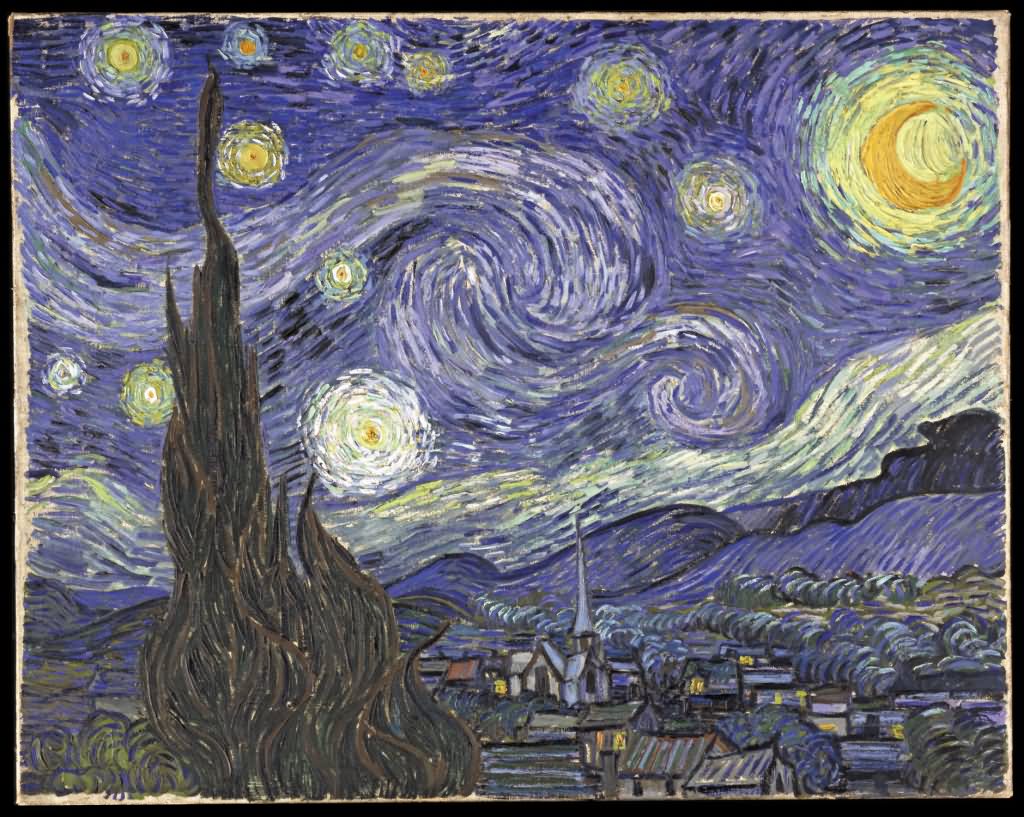The Starry Night
Appreciation

The Starry Night Nederland Vincent van Gogh Gallery and Appreciation
The Starry Night is probably Vincent van Gogh's most famous painting. Instantly recognizable because of its unique style, this work has been the subject of poetry, fiction, CD-ROMs as well as the well known song "Vincent" or "Starry, The Starry Night" by Don McLean.
While there's no denying the popularity of The Starry Night, it's also interesting to note that there is very little known about Vincent's own feelings toward his work. This is mainly due to the fact that he only mentions it in his letters to Theo twice (Letters 595 and 607), and then only in passing. In his correspondence with his brother, Vincent would often discuss specific works in great detail, but not so in the case of The Starry Night. Why? It's difficult to say.
The Starry Night was painted while Vincent was in the asylum at Saint-Rémy and his behaviour was very erratic at the time, due to the severity of his attacks. Unlike most of Van Gogh's works, The Starry Night was painted from memory and not outdoors as was Vincent's preference. This may, in part, explain why the emotional impact of the work is so much more powerful than many of Van Gogh's other works from the same period.
Some people have made stylistic comparisons to Vincent's other well known and equally turbulent work Wheatfield with Crows. Does the tumultuous style of these works reflect a tortured mind? Or is there something more we can read within the whorls Vincent's raging night sky? This is what makes Starry Night not only Vincent's most famous work, but also one of its most frequently interpreted in terms of its meaning and importance.
Some people have speculated about the eleven stars in the painting. While it's true that Vincent didn't have the same religious fervour in 1889, when he painted the work, as he did in his earlier years, there is a possibility that the story of Joseph in the Old Testament may have had an influence on the composition of the work.
'Look, I have had another dream' he said, 'I thought I saw the sun, the moon and eleven stars, bowing to me.'
Genesis 37:9
Whatever the interpretations or underlying meanings, The Starry Night stands out as one of the most important works of art produced in the nineteenth century.
The Starry Night, painted in 1889, Vincent van Gogh left behind the Impressionist doctrine of truth to nature in favour of restless feeling and intense colour, as in this highly charged picture, a touchstone for all subsequent Expressionist painting. The composition of The Starry Night can generally be divided into three specific sections, each adding their own aspects and power to the impression derived from the painting.
First, Van Gogh's night sky is a field of roiling energy. It is filled with swirling clouds, a bright crescent moon and stars ablaze with their own luminescence. The stars in the night sky are indeed surrounded by their own orbs of light. This depiction of the sky keeps the viewer's eyes moving about the painting, following the curves and creating a visual dot to dot with the stars. Through this movement, the painting keeps the onlooker involved while the other factors take hold.
It is note worthy that Van Gogh had already, during his time in Arles, repositioned Ursa Major from the north to the south in his painting Starry Night Over the Rhone. This is repeated here.
Van Gogh wrote of the impression that led to the painting to his brother Theo: "This morning I saw the country from my window a long time before sunrise, with nothing but the morning star, which looked very big." This morning star, or Venus, may be the large white star just left of centre in The Starry Night.
Below the exploding stars, among the rolling hills of the horizon, the village is a place of quiet order. There is a peaceful essence flowing from the structures with the cool dark colours and fiery windows. This brings a sense of stability onto the town, while also bringing with it a sense of size and seclusion. Though often considered to be the village of Saint-Remy, the village is made-up, with the spire of the church evoking van Gogh's native Netherlands. Just like its daytime companion, The Olive Trees, Starry Starry Night is rooted in memory and imagination.
To the left in the painting there is a massive dark structure which brings the connection between the earth and sky, magnificent when compared to the scale of other objects in the painting. Flame-like in its appearance, this is a cypress tree, a tree sort normally associated with mourning and graveyards. Not that death was an ominous subject for Van Gogh. "Looking at the stars always makes me dream," he said, "Why, I ask myself, shouldn't the shining dots of the sky be as accessible as the black dots on the map of France? Just as we take the train to get to Tarascon or Rouen, we take death to reach a star."